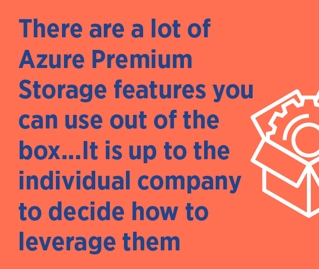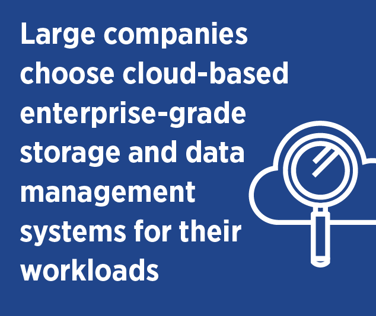Subscribe to our blog
Thanks for subscribing to the blog.
February 6, 2018
Topics: Cloud Volumes ONTAP AzureAdvanced7 minute read
Large companies choose cloud-based enterprise-grade storage and data management systems for their workloads because they not only need to store their business information, they also need additional features such as high performance, high availability, and redundancy.For many companies, meeting those challenges means using storage backed by solid state drives (SSD). On Azure, SSD is offered as Azure Premium Storage.This post will take a closer look at how Azure Premium Storage works, and show you how to get even more benefits from it by using NetApp’s hybrid cloud data management software, Cloud Volumes ONTAP (formerly ONTAP Cloud) for Azure.
Azure Storage
Storage Services are some of the fundamental services used in conjunction with all the other Azure cloud offerings. You can choose from a variety of storage services available on Azure to meet your workload’s needs. Blob Storage is used for storing virtually any type of file you need. Blob Storage is differentiated into three types of blobs:
-
Block blobs
-
Append blobs
-
Page blobs
Block blobs are for storing general files, append blobs are optimized for append operations on existing files, and page blobs are best for storing frequently-accessed or changed 512k pages. Page blobs can also be referred to as “unmanaged disks,” with which you need to manage all aspects of the storage account.
Other Azure storage services include Azure Files, Table storage, Queue storage and Disk storage. Azure Files file storage is an abstracted file share with SMB and RESTful API support. Table storage is NoSQL storage for semi-structured, non-relational data. Queue storage is used to store and process messages in FIFO manner. Disk storage is intended for running VM workloads in the cloud. Disk storage is also known as Azure’s “managed disks” service, meaning Azure manages the entire storage account for you.
Azure storage is also differentiated into two performance tiers:
-
Standard Storage: Storage running on conventional disks, offering all the availability and scaling features but not extraordinary performance.
-
Premium Storage: Storage service running on SSD drives, more of which we’ll discuss in detail below.
Azure Premium Storage
Unlike Standard Storage, the Premium Storage tier only supports storage for virtual machines that require low latency and intensive I/O operations. These are essential for enterprise-grade workloads.
Management
 For managing your Premium Storage account, you can use the Azure portal, Azure Powershell or REST API.
For managing your Premium Storage account, you can use the Azure portal, Azure Powershell or REST API.
When creating a storage account for your premium workloads, you can only specify Locally redundant storage, which means that your premium disks will have two replicas inside the same data center for ensuring the high availability of the underlying infrastructure.
Additionally, for page blobs using Premium Storage, you can set the access tier based on how often your data is going to be accessed. You can also select the secure transfer option, which only allows secure protocols access, and even defines specific Azure Virtual Networks you want to grant access.
Premium disks could be attached as an operating system or data drive but, unlike VM disks backed by standard storage where you can specify custom disk size up to 4 TB, Premium Storage disks are offered only in templates differing in size, IOPS, and throughput.
Since all limits are applied per disk level, if you require more performance for your VMs you can group disks together by establishing software RAID inside your machines or use third-party software, such as Cloud Volumes ONTAP Cloud, on top of Azure Storage.
Virtual Machine Selection
In order to use Premium Storage disks, you must choose a virtual machine series that supports this kind of storage: That means a VM type that allows you to use both Premium and Standard drives on the same VM of up to 256 TB capacity per machine. However, Azure also applies a hard limit for IOPS for each VM size, so it is possible you will underutilize high-performance disks if the machine sizing is not suitable for that rate of performance.
Caching
Any Premium disk instance can utilize caching features, allowing you to choose from “Read-only” and “ReadWrite” options.
“Read-only” holds frequently-accessed data such as database query results, for example. “ReadWrite” caching is used if you want to add the capability for write operations to be cached in RAM before writing data to Azure Storage.
Of course, you can choose not to use caching features altogether. Before applying any such caching configuration, you should definitely analyze your applications and do proper performance design for running those features in Azure.
Monitoring
When it comes to monitoring, you can use VM Diagnostics extension in order to read performance information from the virtual machine itself. For more detailed and long-term monitoring, you should consider using Azure Log Analytics, part of Azure’s Operations Management Suite, where you can configure advanced reporting, dashboards, alerts and much more for your Premium workloads.
Protection
By utilizing Azure Recovery Services, or by taking snapshots, you can develop a business continuity solution for your SSD workloads. However, Recovery Services utilize Standard Storage accounts for storing replicas, so expect a corresponding level of performance during recovery.
Recovery Services allows you to replicate backup sets between three Azure data centers for better data resiliency. Pricing options for managed and unmanaged Premium disks are the same, except the availability of disk templates differs to some extent.
Operating System
From the guest OS point of view, Azure will provide you with support for both Windows and Linux environments. That dual support unlocks the possibility of running a variety of enterprise applications in Azure IaaS.
For instance, you can run your SAP or Dynamics solution, a variety of database services such as Microsoft SQL Server or Oracle, all supported by both Microsoft and the software vendor. You can choose to build a solution such as SQL server or SAP from scratch, deploy one pre-built from the Azure Marketplace, or migrate a virtual machine from an existing on-premises workload.
Likewise, you can move your existing Azure or other workloads to Premium Storage. One way that enterprise workloads using Premium Storage can be further enhanced is with Cloud Volumes ONTAP for Azure storage.
Cloud Volumes ONTAP and Azure Storage
Cloud Volumes ONTAP is the NetApp data management solution that provides you with extensive protection, clear vision, and unified control for your workloads storage.
extensive protection, clear vision, and unified control for your workloads storage.
Cloud Volumes ONTAP is useful for a wide range of use cases on Azure. WithCloud Volumes ONTAP, you get to control your storage infrastructure for both on-premises and cloud environments by adding enterprise-grade NetApp storage features on top of Azure storage.
Cloud Volumes ONTAP’s powerful storage-efficiency features such as data deduplication, data compression and thin provisioning make it possible to dramatically cut the amount of storage space used on Azure Premium Storage.
SnapMirror® technology allows existing NetApp storage system users to replicate data between on-premises data centers and Azure, making it easy to keep different environments synchronized and up to date. UsingCloud Volumes ONTAP’s FlexClone® technology you can easily provision isolated test environments based on production replicas.
Cloud Volumes ONTAP can also be used as part of a disaster recovery strategy by setting up secondary DR sites and taking cost-effective snapshots in order to create instant recovery points of your data. TheseCloud Volumes ONTAP snapshots only update the data that has changed from previous versions of the snapshot, making them a less expensive alternative to native cloud-based snapshots.
Cloud Volumes ONTAP is able to use different storage protocols such as NFS, CIFS or iSCSI within a single architecture. It also can apply additional measures such as encryption at rest, which will boost your security, fully supported in Azure. To see more about how Cloud Volumes ONTAP can save your storage costs on Azure, you can use NetApp’s Azure calculator to adjust your VM size, Azure disk storage consumption, the storage type’s efficiency, and uptime alongside Cloud Volumes ONTAP.
Summary
There are a lot of Azure Premium Storage features you can use out of the box, such as encryption, caching, snapshots, and monitoring: It is up to the individual company to decide how to leverage them.
Some companies operate in hybrid environments with Azure cloud, while others use cloud-only or multi-cloud architectures. As these environments begin to grow in complexity and cost, that is where Cloud Volumes ONTAP steps in.
Cloud Volumes ONTAP for Azure is an ideal solution to unify storage systems into a single pane of glass and reduce storage costs through the use of advanced NetApp protocols and storage-efficiency features.

